Globally and in the United States, the software industry is booming, despite the recent onset of downsizing. The promise of technology evolution is leading companies towards expansion. Business owners and software developers choose a suitable technology stack to better serve the users during 2023.
With the business requirements at hand, it becomes imperative to find an appropriate technology stack for building products/services. For example, the MERN stack empowers ReactJS developers to build a robust website or a web app. As the scale, and business model deviates; companies must be exact in figuring out the right tech stack.
Consequently, this enables them to sustain, and thrive in their business. Without the apt tech stack, any great product can miss the mark. Failure is the biggest setback that any company can face especially in the current global recession.
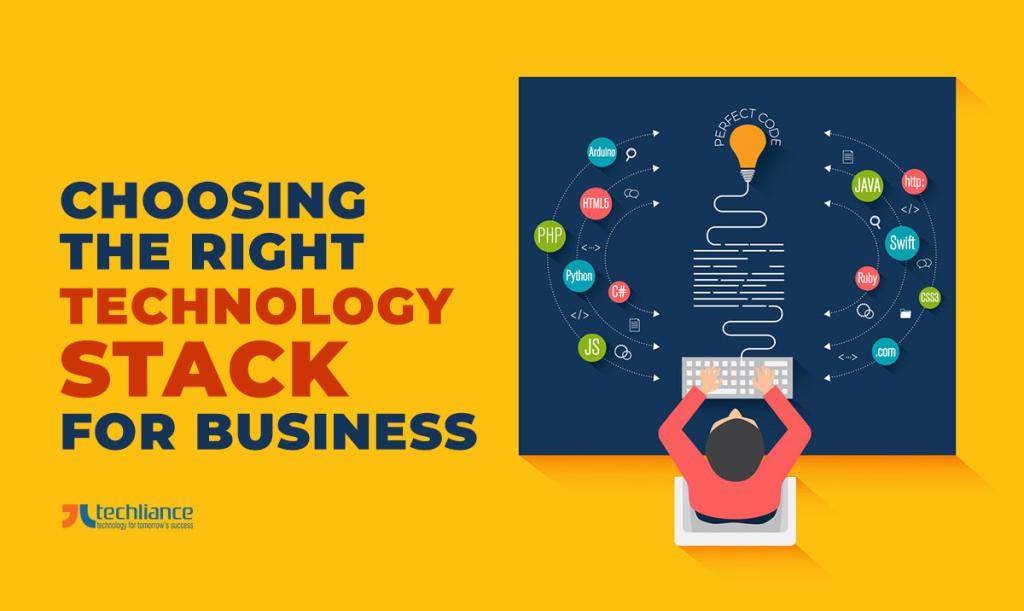
What is a technology stack?
A technology stack is a combination of different elements that help to get a desirable result. This is also known as a solution stack, application stack, software stack, or tech stack. It is about finding the right mix of technologies, frameworks, front-end as well as back-end tools, databases, and languages.
Some usages of technology stacks include the creation of products, execution of business operations, and analysis of performance metrics. In the software industry, a solution stack is a set of programming languages, application tools, and relevant technologies. The purpose of a technology stack is to work as a complete system or platform to build and run applications.
So that you don’t require some additional subsystems for carrying out different tasks. Accordingly, the resulting applications run on this comprehensive system/platform. Also, it is important to note that your commercial success depends on the pertinent tech stack.
Subsequently, it allows your team to not just build but maintain the product. You can’t go wrong in this selection of the software stack. Because once you start the work on the project, you cannot keep on changing the stack.
The longevity of the product is a crucial factor here. This helps in identifying the chances of market success for your solution. Eventually, it is all about the scalability of your business.
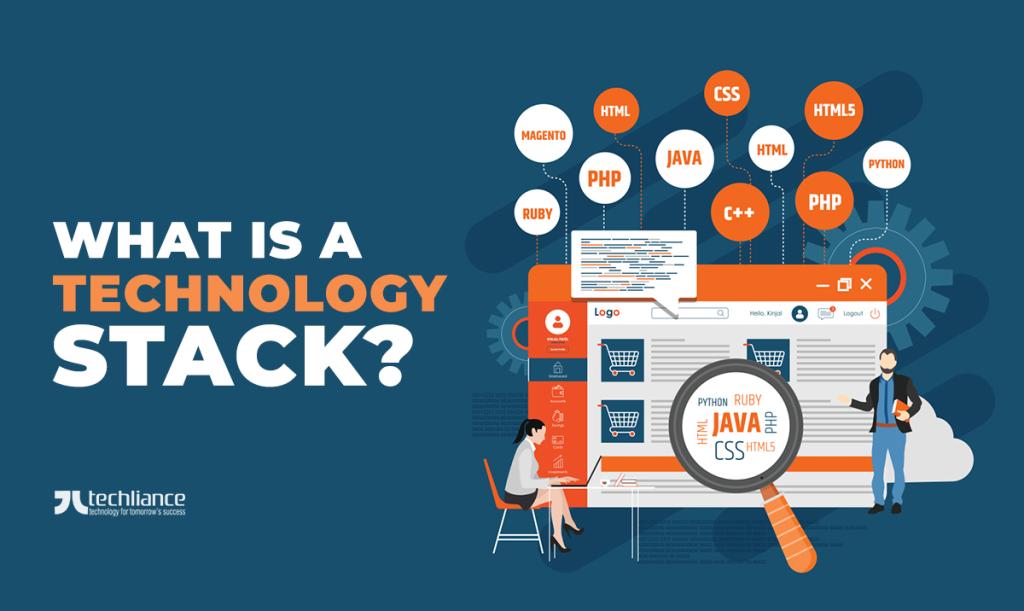
The evolution of modern tech stack
Once, there were SaaS products and services, it was easier to deduce the technology stacks in definite boxes of subsets. For instance, operating systems, web servers, databases, and web programming languages. This made it easier to consider what was the requirement, to simply execute the clear plan to build the solution.
Remember the good old days of the LAMP stack, when web development was fairly simple? Even, the business use cases were not that demanding. Then came the SaaS line of products where subscription-based consumption became the norm.
Handling users on account of their subscription, access, and usage became necessary. It came down to what they could do through the available services to them. Ever-growing use cases brought a new layer of complexity, that a basic tech stack model could not suffice.
The need of the day was to evolve and get on with the demands of the users. Application simplicity is paramount, but so is the ability to solve complex cases. So, it narrows down to finding the resourceful tech stack, to make the perfect product for the market segment.
Technology stacks have undergone a lot of progressions, such as MEAN/MERN stacks. Companies in the early start-up stages usually deviate towards low-cost and flexible options. Nonetheless, scalability is always something that you need to bear in mind.
This is not just applicable to startups and small businesses. Additionally, this is true for enterprise-level products. These products eventually get maximum market traction in the longer run.
Components of a technology stack
We have already gone through a generic overview of the technology stack. Now, we get a little deeper in our discussion about the application stacks. Keep in mind that solution stacks have different elements.
Given below are the major components of the software stacks. A tech stack doesn’t need to include all of these elements. But an application stack covers some of these parts.
- Operating systems and UI
- Programming languages
- Runtime environments
- Servers and load balancing
- Data storage
Let’s discuss these components of technology stacks.
Operating systems and UI
This is a no-brainer, as operating systems are platforms on which any software application functions. Together with UI, an operating system is just like the wand for the magician to start any spell. Some popular operating systems are Android, Windows, iOS, Linux, macOS, Unix, and ChromeOS.
Programming languages
Without a computer language, what can a programmer possibly do to code? An efficient development environment you are comfortable coding with is crucial for any application you want to build. Some great programming languages are Java, R, Swift, Go, JavaScript, Rust, PHP, Dart, Ruby, Python, C#, Kotlin, etc.
Servers and load balancing
The powerful servers and load-balancing services, do all the magic behind your spell. For example, they cover routing, caching services, content distribution networks, etc. By using these, your application can send and receive requests with efficient running.
Even they allow the scaling capacity you may need. Just like increasing or enhancing the servers as your business grows. The biggest giveaways are Amazon, Google, Microsoft, Salesforce, Oracle, and Alibaba web/cloud servers.
They have a huge potential in letting businesses scale up. Also, businesses can pay for the services as they expand. Some prevalent names in this category include AWS, Google Cloud Platform, Azure, Apache, Nginx, Cloudflare, and Fastly.
Data storage
This is the final piece of the puzzle that cements the technology stack. It covers relational/non-relational databases, cloud storage, data warehouses, and data pipelines for saving your data. Some common examples are MySQL, Oracle, MongoDB, SQL Server, MariaDB, PostgreSQL, Redis, SQLite, Elasticsearch, Firebase/Firestore, DynamoDB, Cassandra, Neo4j, etc.
Major types of technology stacks on basis of usage
There are no textbook criteria that constitute a technology stack. However, we can divide software stacks into different categories. In 2023, these are a few kinds of application stacks that are valuable for businesses globally and in the USA.
- Web technology stacks
- Native mobile technology stacks
- Hybrid technology stacks
- Cross-platform technology stacks
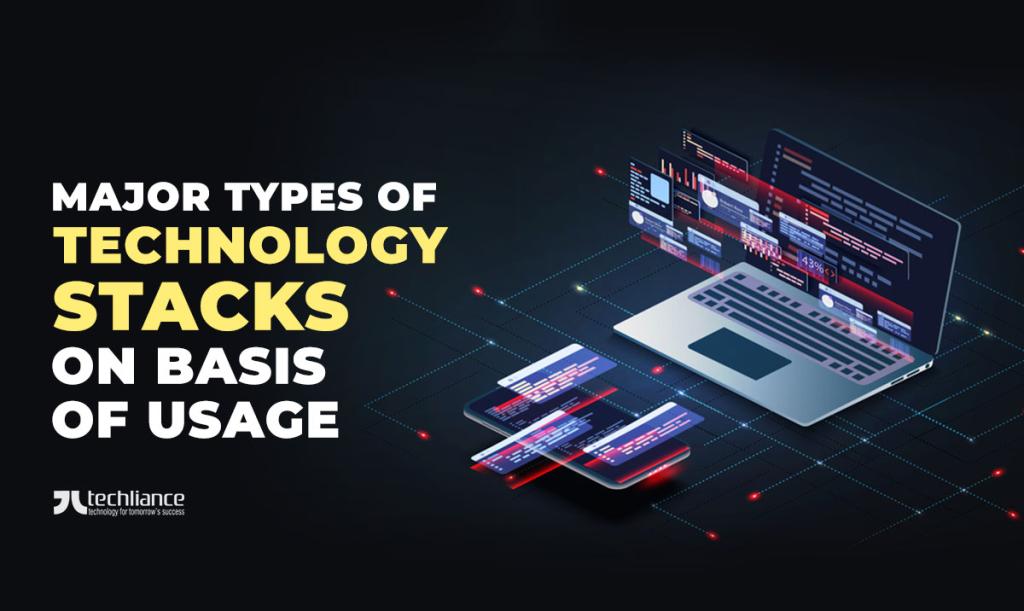
Here, we deliberate over these types of solution stacks on a usage basis briefly.
Web technology stacks
The web technology stacks enable the development of web applications and websites. Moreover, they cover both the front-end and back-end of these web-driven solutions. For instance, MEAN stack, LAMP stack, and Jamstack.
Native mobile technology stacks
The mobile technology stacks facilitate the creation of mobile applications. Although, there are no proper acronyms for them like for web technology stacks. The point is that any set of software/technologies that can build mobile apps; is a mobile tech stack.
Mostly, they enable developers to build native mobile applications. Therefore, some people also call them native mobile technology stacks. A native mobile technology stack can comprise these components.
- Swift/Objective-C (Languages for iOS)
- Kotlin/Java/C++ (Languages for Android)
- Xcode/AppCode, Android Studio/Android NDK (Development tools)
- SwiftUI, UIkit, Android UI, Jetpack Compose (UI frameworks)
- MySQL, MongoDB, MariaDB (Database system)
- Amazon S3, Azure Blob, Google Filestore (Cloud storage)
Cross-platform technology stacks
There are some cross-platform technology stacks. A single cross-platform framework replaces two native mobile languages. Nevertheless, they also don’t have acronyms yet.
A cross-platform technology stack can make use of any of React Native, Xamarin, or Flutter. React Native takes advantage of ReactJS. So, your web developer can prove handy as well.
Microsoft’s very own Xamarin utilizes C# language. Flutter by Google employs Dart language. NativeScript is another option among the cross-platform technology stacks.
Classification of solution stacks upon technology
We can classify software stacks on basis of technology as well.
- JavaScript technology stacks
- Linux technology stacks
- Windows technology stacks
- BSD technology stacks
- Other technology stacks
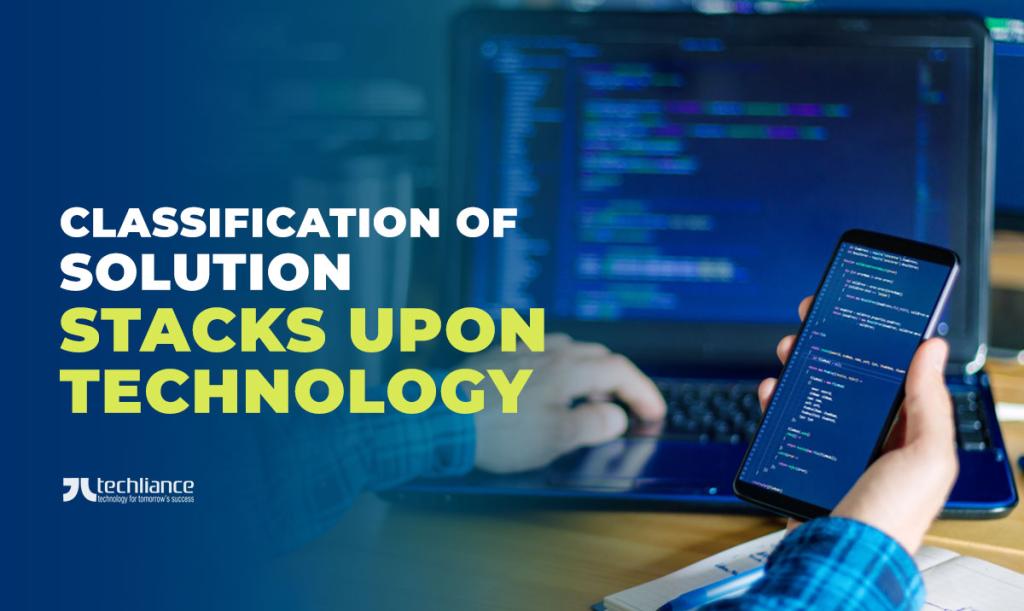
Next, we contemplate this cataloging of application stacks on a technology basis.
JavaScript technology stacks
These are some famous JavaScript-driven tech stacks that are usable through 2023.
- MEAN stack
- MERN stack
- MEVN stack
- MEEN stack
- MEN stack
- PERN stack
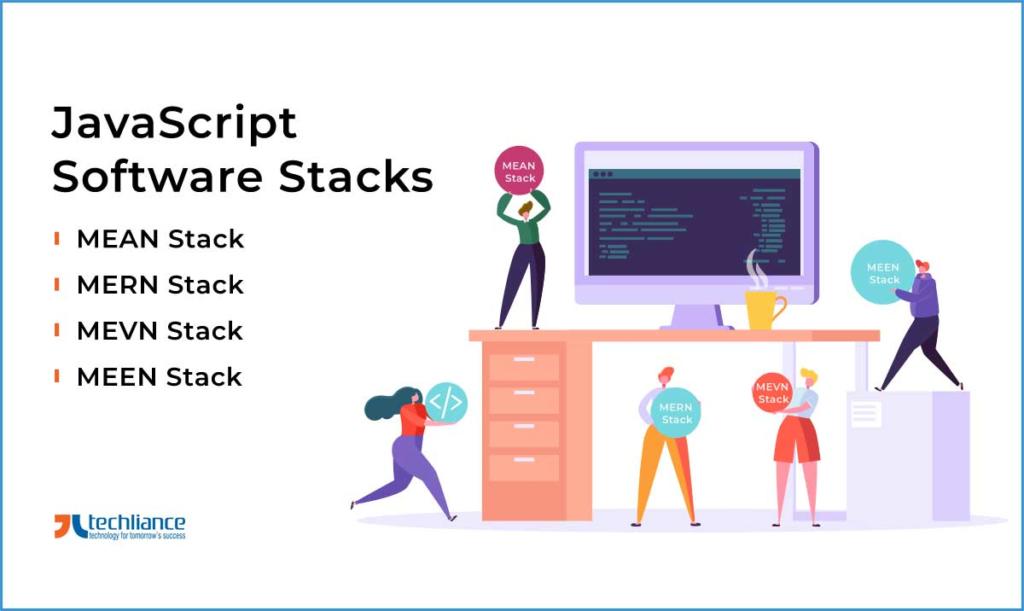
Moving forward, we have a look at some well-known JavaScript-centric application stacks.
MEAN Stack
These technologies constitute the MEAN stack.
| MongoDB | Database management system |
| Express.js | Backend web framework |
| AngularJS/Angular | Frontend web framework |
| Node.js | JavaScript runtime |
MERN stack
These technologies constitute the MERN stack.
| MongoDB | Database management system |
| Express.js | Backend web framework |
| React.js | Frontend web framework |
| Node.js | JavaScript runtime |
MEVN stack
These technologies constitute the MEVN stack.
| MongoDB | Database management system |
| Express.js | Backend web framework |
| Vue.js | Frontend web framework |
| Node.js | JavaScript runtime |
MEEN stack
These technologies constitute the MEEN stack.
| MongoDB | Database management system |
| Express.js | Backend web framework |
| Ember.js | Frontend web framework |
| Node.js | JavaScript runtime |
MEN stack
These technologies constitute the MEN stack.
| MongoDB | Database management system |
| Express.js | Backend web framework |
| Node.js | JavaScript runtime |
PERN stack
These technologies constitute the PERN stack.
| PostgreSQL | Database management system |
| Express.js | Backend web framework |
| React.js | Frontend web framework |
| Node.js | JavaScript runtime |
Linux technology stacks
Here are a few older Linux-driven technology stacks, from which some are still appropriate to use today.
- GLASS stack
- LAMP stack
- LAPP stack
- LEAP stack
- LEMP/LNMP stack
- LLMP stack
- LYCE stack
- LYME stack
We take a look at these Linux-centric technology stacks.
GLASS stack
These technologies constitute the GLASS stack.
| GemStone | Database and application server |
| Linux | Operating System |
| Apache | Web Server |
| Smalltalk | Programming language |
| Seaside | Web framework |
LAMP stack
These technologies constitute the LAMP stack.
| Linux | Operating System |
| Apache | Web Server |
| MySQL or MariaDB | Database management system |
| PHP/Pearl/Python | Programming language |
LAPP stack
These technologies constitute the LAPP stack.
| Linux | Operating System |
| Apache | Web Server |
| PostgreSQL | Database management system |
| PHP/Pearl/Python | Programming language |
LEAP stack
These technologies constitute the LEAP stack.
| Linux | Operating System |
| Eucalyptus | Amazon Elastic Compute Cloud’s alternative |
| AppScale | Google App Engine’s alternative |
| Python | Programming language |
LEMP/LNMP stack
These technologies constitute the LEMP/LNMP stack. It is known as LEMP stack because of the pronunciation of Nginx as Engine-X (en-juhn-ecks). Some people call it LNMP stack anyways.
| Linux | Operating System |
| Nginx | Web Server |
| MySQL or MariaDB | Database management system |
| PHP/Pearl/Python | Programming language |
LLMP stack
These technologies constitute the LLMP stack.
| Linux | Operating System |
| Lighttpd | Web Server |
| MySQL or MariaDB | Database management system |
| PHP/Pearl/Python | Programming language |
LYCE stack
These technologies constitute the LYCE stack.
| Linux | Operating System |
| Yaws | Web Server |
| CouchDB | Database management system |
| Erlang | Programming language |
LYME stack
These technologies constitute the LYME stack.
| Linux | Operating System |
| Yaws | Web Server |
| Mnesia | Database management system |
| Erlang | Programming language |
Windows technology stacks
These are some Microsoft Windows-driven technology stacks of note.
- WAMP stack
- WIMP stack
- WIPP stack
- WINS stack
- WISA stack
- WISAV stack
- WISP stack
- WIPAV stack
Here we have a peek at these Windows-centric technology stacks.
WAMP stack
These technologies constitute the WAMP stack.
| Windows | Operating System |
| Apache | Web Server |
| MySQL or MariaDB | Database management system |
| PHP/Pearl/Python | Programming language |
WIMP stack
These technologies constitute the WIMP stack.
| Windows | Operating System |
| Internet Information Services (IIS) | Web Server |
| MySQL or MariaDB | Database management system |
| PHP/Pearl/Python | Programming language |
WINS stack
These technologies constitute the WINS stack.
| Windows | Operating System |
| Internet Information Services (IIS) | Web Server |
| .NET | Software framework |
| SQL Server | Database management system |
WIPP stack
These technologies constitute the WIPP stack.
| Windows | Operating System |
| Internet Information Services (IIS) | Web Server |
| PostgreSQL | Database management system |
| PHP | Programming language |
WISA stack
These technologies constitute the WISA stack.
| Windows | Operating System |
| Internet Information Services (IIS) | Web Server |
| SQL Server | Database management system |
| ASP.NET | Web framework |
WISAV stack
These technologies constitute the WISAV stack.
| Windows | Operating System |
| Internet Information Services (IIS) | Web Server |
| SQL Server | Database management system |
| ASP.NET | Backend web framework |
| Vue.js | Frontend web framework |
WISP stack
These technologies constitute the WISP stack.
| Windows | Operating System |
| Internet Information Services (IIS) | Web Server |
| SQL Server | Database management system |
| PHP | Programming language |
WIPAV stack
These technologies constitute the WIPAV stack.
| Windows | Operating System |
| Internet Information Services (IIS) | Web Server |
| PostgreSQL | Database management system |
| ASP.NET | Backend web framework |
| Vue.js | Frontend web framework |
BSD technology stacks
Getting aware of BSD-driven technology stacks improves your knowledge.
- BCHS stack
- BAMP stack
- BAPP stack
- DAMP stack
- FAMP stack
- MAMP stack
- SAMP stack
Let’s briefly describe the meaning of these BSD-centric technology stacks.
BCHS stack
These technologies constitute the BCHS stack.
| OpenBSD | Operating System |
| C | Programming language |
| httpd | Web server |
| SQLite | Database engine |
BAMP stack
These technologies constitute the BAMP stack.
| BSD | Operating System |
| Apache | Web Server |
| MySQL | Database management system |
| PHP/Pearl/Python | Programming language |
BAPP stack
These technologies constitute the BAPP stack.
| BSD | Operating System |
| Apache | Web Server |
| PostgreSQL | Database management system |
| PHP/Pearl/Python | Programming language |
DAMP stack
These technologies constitute the DAMP stack.
| Darwin | Operating System |
| Apache | Web Server |
| MySQL | Database management system |
| PHP | Programming language |
FAMP stack
These technologies constitute the FAMP stack.
| FreeBSD | Operating System |
| Apache | Web Server |
| MySQL | Database management system |
| PHP/Pearl/Python | Programming language |
MAMP stack
These technologies constitute the MAMP stack.
| macOS | Operating System |
| Apache | Web Server |
| MySQL or MariaDB | Database management system |
| PHP/Pearl/Python | Programming language |
SAMP stack
These technologies constitute the SAMP stack.
| Solaris | Operating System |
| Apache | Web Server |
| MySQL | Database management system |
| PHP/Pearl/Python | Programming language |
Other technology stacks
Keep an eye on these other technology stacks as well.
- ELK stack
- JAMstack
- MARQS stack
- MLVN stack
- NMP stack
- PLONK stack
- SMACK stack
- T-REX stack
- XAMPP stack
- XRS stack
Lastly, we have a look at these other technology stacks.
ELK stack
These technologies constitute the ELK stack. Combining it with Beats (data shippers) transforms it into the Elastic stack. Which is open to various further integrations.
| Elasticsearch | Search Engine |
| Logstash | Data processing pipeline for event and log management |
| Kibana | Data visualization dashboard |
JAMstack
These technologies constitute the JAMstack.
| JavaScript | Programming language |
| APIs | Interfacing for business logic and 3rd party services |
| Markup | Content pages with Static HTML |
MARQS stack
These technologies constitute the MARQS stack.
| Apache Mesos | Distributed systems kernel |
| Akka | Toolkit for actor-based concurrency implementation |
| Riak | Distributed NoSQL data store |
| Apache Kafka | Event streaming platform |
| Apache Spark | Analytics engine for data processing |
MLVN stack
These technologies constitute the MLVN stack.
| MongoDB | Database management system |
| Linux | Operating System |
| Varnish | HTTP accelerator for frontend cache |
| Node.js | JavaScript runtime |
NMP stack
These technologies constitute the NMP stack.
| Nginx | Web Server |
| MySQL or MariaDB | Database management system |
| PHP | Programming language |
PLONK stack
These technologies constitute the PLONK stack.
| Prometheus | Event monitoring in real time |
| Linkerd | Service mesh for Kubernetes |
| OpenFaaS | Deploy serverless functions |
| NATS | Cloud-native messaging system |
| Kubernetes | Automating deployment of container applications |
SMACK stack
These technologies constitute the SMACK stack.
| Apache Spark | Analytics engine for data processing |
| Apache Mesos | Distributed systems kernel |
| Akka | Toolkit for actor-based concurrency implementation |
| Apache Cassandra | Database management system |
| Apache Kafka | Event streaming platform |
T-REX stack
These technologies constitute the T-REX stack.
| TerminusDB | Knowledge graph and document-oriented database |
| React | Frontend web framework |
| Express.js | Backend web framework |
XAMPP stack
The developers seem to use XAMPP as a recursive acronym for XAMPP Apache + MariaDB + PHP + Perl. Originally, it utilized MySQL for the database, which was replaced with MariaDB in October 2019. X stands for cross-platform in the apparent acronym of XAMPP.
These technologies constitute the XAMPP stack.
| X | Cross-platform |
| Apache | Web Server |
| MariaDB | Database management system |
| PHP | Programming language |
| Pearl | Programming language |
XRS stack
These technologies constitute the XRS stack.
| XML database | BaseX/eXist/MarkLogic Server/Qizx |
| XQuery | Programming language |
| REST | Communication interface |
| XForms | Collecting input |
FAQs about technology stacks
These are some frequently asked questions (FAQs) regarding technology stacks.
MEAN stack, MERN stack, and JAMstack are examples of modern technology stacks. LAMP stack, WAMP stack, WINS, WAMP stack, etc. are examples of old tech stacks.
The general-purpose Java language is high-level and so it has multiple usages. You can program the front end using Swing, and the JavaFX platform. Also, you can use it for the backend language of your tech stack with Java server pages (JSP), and servlets.
Java’s write-once, run-anywhere (WORA) nature enables you to code almost every part of a web application. It figuratively makes Java a full-stack language. For this reason, some people consider Java close to a tech stack.
Different companies have diverse requirements. So the tech stacks they need are not alike. For choosing a technology stack, carefully evaluate your business goals. Build on a core programming language and a framework. Utilize additional tools, and add extra services as you go.
The high-level Python language is multi-purpose in nature. You can code the front-end and back-end of web applications in it. Its efficient libraries empower you to build web applications without wasting server-side resources. The suitability of Python for both the front end and back end makes it a full-stack language. That’s why some people also call Python closer to a technology stack.
About the Author




